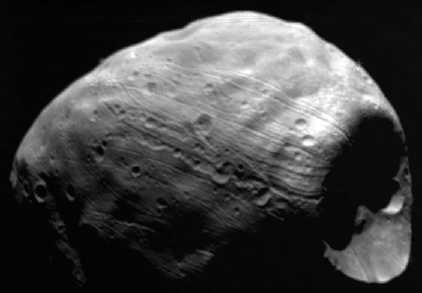Every day, in the afternoon (evening for some people), I'll be adding a topic on a controversial or interesting thing in the Solar System. At the end, I'll leave a question or idea for people to think and discuss about in the comments section. I hope you find it both interesting and informative at the same time.
First in line
the mysterious 'scratches' on Phobos
 | ||
| A visualization of the 'lines' on Phobos. Credit: NASA |
Of all of the moons in the Solar System, you'd be hard-pressed to find an odder moon than Phobos. Not only does it have a controversial origin and the largest crater in ratio to moon size in the Solar System, but it has a series of mysterious lines traveling parallel across its surface. The origin of them is controversial, but here are a few of the leading theories, including evidence for and against them.
The most widely accepted theory is that the lines are crater chains, or a group of related impact craters caused by larger bodies' gravity pulling apart the impacting asteroid or comet.
 | |
| Enki Catena, a crater chain on Ganymede. Credit: JPL/NASA |
The lines do appear to be made up of separate strings of craters, with slight separation between them sometimes, but most of the lines are straight and all appear to come from the same side. How could that have happened?
It works similar to why we only see one side of the Moon at any one time. Phobos, along with many other satellites in the Solar System, is tidally locked with Mars, meaning that it always shows the same face. This also means that one side will always be facing 'forwards' and one side will always be facing 'backwards'. That means the forward side will most likely get more crater impacts than the backward side. The current theory is that temporary satellites caught by Mars's gravity will sometimes break apart and impact Phobos, leaving impact lines on the surface. This is the most widely accepted, but here are a few more explanations:
Another theory is that the impact that made Stickney crater, a crater on the side of Phobos, should have nearly shattered the moon, leaving only tiny pieces in a ring around Mars. However, it obviously didn't, so it's possible that the lines are actually cracks in the surface that later got filled with a layer of dust on Phobos, making them appear more like lines than cracks. This seems to hold true in that measurements by the Mars Express satellite show Phobos to have a fairly low density of 1.88 grams per cubic centimeter. For comparison, Saturn has a density of 0.687 g/cm3, and Earth has a density of 5.515 g/cm3. Based on the density, it's likely that about 30% of the moon is hollow. While that seems fairly accurate, if the cracks originated from Stickney's impact, they would probably originate from that, but observations show that the lines don't originate from Stickney. However, while this makes it less likely for that theory to be true, it doesn't prove it wrong. More observations are still needed.
The last theory (you knew this was coming) is that Phobos is actually an artificial satellite created by extraterrestrials. The lines appear to straight to be naturally-created, and many missions directly to Phobos have failed. For instance, the Russian probe Phobos II was sent to Phobos in 1988-1989, with a mission to send a lander to study the planet. However, slightly before it was set to send the lander down, it suddenly lost connection. Right before, though, it sent 2 interesting images of the area around it.
The last theory (you knew this was coming) is that Phobos is actually an artificial satellite created by extraterrestrials. The lines appear to straight to be naturally-created, and many missions directly to Phobos have failed. For instance, the Russian probe Phobos II was sent to Phobos in 1988-1989, with a mission to send a lander to study the planet. However, slightly before it was set to send the lander down, it suddenly lost connection. Right before, though, it sent 2 interesting images of the area around it.
| The last image taken. Credit: Soyuz program |
| The 2nd last image taken. Credit: Soyuz program |
The first image can be easily recognized as a diffraction spike caused by a nearby star, planet, or even Mars itself. However, the second image appears to be a shadow of something. Most UFO enthusiasts agree that it's a cylindrical UFO, but it could also be the shadow of an asteroid or the satellite itself from an angle. Nevertheless, the dissapearance of Phobos II hasn't been explained successfully. Beyond the mysterious disappearance, Phobos has an unusually low density for an asteroid, which could be because it's a large space ship orbiting Mars. This idea was proposed in 1958 by Iosif Samuilovich Schlovsky, but later generally accepted not to be true due to fact that measurements that brought the theory up turned out to be false through more detailed measurements. And, at any rate, there's still something that the UFO conspiracy theorists try to avoid explaining even more than the government supposedly does: Why on Earth would an advanced alien species build an obviously conspicuous satellite to orbit Mars yet put so much effort into destroying any satellites to study it?
No matter what the cause of the lines on Phobos are, whether it be crater chains, fractures, or UFOs, it's certainly an interesting topic to discuss. But what do you think is probably the most likely cause? Post your thoughts below. :)
Stay tuned for future posts tomorrow! :D
No comments:
Post a Comment